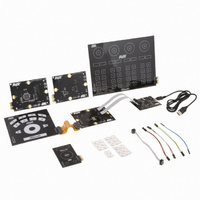ATQT600 Atmel, ATQT600 Datasheet - Page 14

ATQT600
Manufacturer Part Number
ATQT600
Description
KIT EVAL TOUCH FOR QT600
Manufacturer
Atmel
Series
QTouch™r
Specifications of ATQT600
Sensor Type
Touch Screen
Interface
USB
Embedded
Yes, Other
Utilized Ic / Part
ATtiny88, ATmega324PA, ATxmega128A1
Processor To Be Evaluated
ATtiny88, ATmega324, ATxmega128
Data Bus Width
8 bit, 16 bit
Interface Type
USB
Maximum Operating Temperature
+ 85 C
Minimum Operating Temperature
- 40 C
Operating Supply Voltage
1.6 V to 3.6 V
Silicon Manufacturer
Atmel
Kit Application Type
Sensor
Application Sub Type
Touch Sensor
Kit Contents
USB Bridge, MCU Cards, Touchpad Cards
Svhc
No SVHC (15-Dec-2010)
Mcu Supported Families
ATtiny88,
Rohs Compliant
Yes
Lead Free Status / RoHS Status
Lead free / RoHS Compliant
Voltage - Supply
-
Sensitivity
-
Sensing Range
-
Lead Free Status / Rohs Status
Lead free / RoHS Compliant
Available stocks
Company
Part Number
Manufacturer
Quantity
Price
Company:
Part Number:
ATQT600
Manufacturer:
Atmel
Quantity:
135
10620D–AT42–04/09
General Advice
2.3
2.3.1
2.3.2
2-4
Materials
Substrates
Electrode and Interconnection Materials
Placing the passive components close to the chip, whilst having a long set of tracks to the chip from the
key, negates the desired result, as long tracks act as RF antennas. The series resistor acts to reduce RF
coupling both in and out of the sensor circuit. However, the circuit cannot perform this function on RF
signals coupled into the chip on a long trace between the chip and the resistor.
The substrate is the base material carrying the electrodes.
Almost any insulating material can be used as a substrate, but low-loss substrates are generally
preferable, such as PCB materials (FR4, CEM-1, Polyamide and Kapton to name a few), acrylics like
Polyethylene Terephthalate (PET) or Polycarbonate. Glass is also an excellent material.
Generally, if the substrate under consideration is commonly used for electronic assemblies, then it will
also work well for capacitive sensing. Just be careful to avoid materials that are strongly hydroscopic,
such as those that are paper based, as this can cause
conditions.
When considering the stack of materials that make up the front panel and the sensor substrate, you are
always advised to glue the substrate to the front panel using pressure-sensitive or optically clear
adhesive, or another suitable bonding agent. Small (less than 1 mm diameter) or infrequent air bubbles
in the adhesive are generally acceptable, but large (greater than 2 mm diameter) or frequent bubbles
can cause drops in sensitivity and unit-to-unit variances that are not desirable for mass production.
It is never recommended to simply push the substrate up against the front panel, as it is hard to achieve
consistent sensor performance from unit to unit. Furthermore, moisture can become trapped between
the two layers causing shifts in sensitivity, and optically it is very easy to end up with unsightly Newton
rings
It is possible to construct sensors that do not rely on a substrate. These are described in this document
under separate sections.
Common electrode materials include copper, carbon, silver ink, Orgacon™ and ITO.
The lower the /sq resistivity of the material the better. Less than 1 k/sq is preferred
control of any RC time constants much easier.
Interconnections are usually formed from low /sq material because they tend to be long and thin in
nature. Remember that a printed silver track at 1 k/sq that is 100 mm long and 0.5 mm wide will have a
resistance of 200 k.
1. The colorful diffraction effect that spreads out around the center of a spec of moisture, oil or other contaminant
2. As should be obvious, the
trapped as a thin film between the layers.
thin electrodes or traces build up resistance extremely quickly, even for relatively low resistivities.
(1)
.
/sq rating choice is intimately coupled with the shape and size of the electrode. Long
r
to change substantially with environmental
Touch Sensors Design Guide
(2)
as it makes













